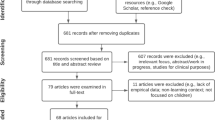Abstract
This paper aims to present findings on the use of eye-tracking technology as a new approach from an educational perspective. The studies in this paper on relationship between learning and eye-movements have focused on concept-map formation, learning from multimedia materials, designing materials with different cognitive strategies, multimodal comprehension of language and graphics with and without annotation, computer games and cognitive style effects of computer based interfaces and hypertext environment. The results of the Middle East Technical University (METU) Human Computer Interaction (HCI) research group’s eye-tracking based research studies presented and discussed how this approach helps educators to better understand learning processes of humans. Understanding and using this innovative approach is important for both educators and researchers in terms of comprehending learning processes deeply.
Chapter PDF
Similar content being viewed by others
References
Just, M.A., Carpenter, P.A.: Using eye fixations to study reading comprehension. In: Kieras, D.E., Just, M.A. (eds.) New methods in reading comprehension research, pp. 151–182. Erlbaum, Hillsdale (1984)
Rayner, K.: Eye movements and cognitive processes in reading, visual search, and scene perception. In: Findlay, J.M., Walker, R., Kentridge, R.W. (eds.) Eye movement research: Mechanisms, processes, and applications, pp. 3–21. Elsevier Science, New York (1995)
Rayner, K.: Eye movements in reading and information processing: Twenty years of research. Psychological Bulletin 124, 372–422 (1998)
Just, M.A., Carpenter, P.A.: Psychological Review: A Theory of Reading: From Eye Fixations to Comprehension. American Psychological Association 87, 4 (1980)
Middle East Tehnical University (METU) Human Computer Interaction (HCI), METU HCI Research Group (2007), http://hci.metu.edu.tr
Clearview User Manual. Tobii, Sweden (2006)
Baran, B., Dogusoy, B., Cagiltay, K.: How do adults solve digital tangram problems? Analyzing cognitive strategies through eye tracking approach. In: Jacko, J.A. (ed.) HCI 2007. LNCS, vol. 4552, pp. 555–563. Springer, Heidelberg (2007)
Yecan, E., Çagiltay, K.: Cognitive Styles and Students’ Interaction with and Instructional Web-Site:Tracing Users through Eye-Gaze. In: The 6th IEEE International Conference on Advanced Learning Technologies, Kerkrade, Netherlands, 5-7 July (2006)
Yecan, E., Sumuer, E., Baran, B., Cagiltay, K.: Tracing Users’ Behaviors in a Multimodal Instructional Material: An Eye-Tracking Study. In: Jacko, J.A. (ed.) HCI 2007. LNCS, vol. 4552, pp. 755–762. Springer, Heidelberg (2007)
Sancar, H., Dogusoy, B., Cagiltay, K., Cakiroglu, J.: Exploring Cognitive Process of Concept Map Construction: An Eye-Tracking Study. In: Association for Educational Communications and Technology (AECT), Orlando, USA (2008)
Sancar, H., Karakus, T., Cagiltay, K.: Learning a New Game: Usability, Gender and Education. In: 3rd Technology-Enhanced Learning Enlargement Workshop: Young Researchers for the European Future of the Technology-Enhanced Learning, Sofia, Bulgaria (2007)
Karakus, T., Sancar, H., Cagiltay, K.: An Eye Tracking Study: The Effects of the Individual Differences on Navigation Patterns and Recall Performance on Hypertexts Environments. In: ED-MEDIA, World Conference on Educational Multimedia, Hypermedia & Telecommunications, Vienna, Austria (2008)
Ozcelik, E., Arslan, I., Cagiltay, K.: Signaling the Keywords or Sentences: An Eye-tracking Study (unpublished manuscript)
Arslan, İ., Ozcelik, E., Cagiltay, K.: Effect of signaling on multimedia learning: An eye tracking approach (unpublished manuscript)
Ozcelik, E., Karakus, T., Kursun, E., Cagiltay, K.: Color Coding Effect on Multimedia Learning and Visual Search: An eyetracking approach. In: The American Educational Research Association (AERA), Chicago, USA (2007)
Dogusoy, B., Cagiltay, K.: Evaluation of Visually Categorized Search Engine. In: 3rd Technology-Enhanced Learning Enlargement Workshop: Young Researchers for the European Future of the Technology-Enhanced Learning, Sofia, Bulgaria (2007)
Acarturk, C., Habel, C., Cagiltay, K., Alacam, O.: Multimodal Comprehension of Language and Graphicsgraphs with and without Annotation. ECEM. In: 14th European Conference on Eye Movements, Potsdam, Germany, August 19-23 (2007)
Chandler, P., Sweller, J.: The split-attention effect as a factor in the design of instruction. British Journal of Educational Psychology 62, 233–246 (1992)
Pan, B., Hembrooke, H., Gay, G., Granka, L., Feusner, M., Newman, J.: The Determinants of Web Page Viewing Behavior: An Eye Tracking Study. In: Proc. ETRA (2004)
Author information
Authors and Affiliations
Editor information
Editors and Affiliations
Rights and permissions
Copyright information
© 2009 Springer-Verlag Berlin Heidelberg
About this paper
Cite this paper
Dogusoy, B., Cagiltay, K. (2009). An Innovative Way of Understanding Learning Processes: Eye Tracking. In: Jacko, J.A. (eds) Human-Computer Interaction. Interacting in Various Application Domains. HCI 2009. Lecture Notes in Computer Science, vol 5613. Springer, Berlin, Heidelberg. https://doi.org/10.1007/978-3-642-02583-9_11
Download citation
DOI: https://doi.org/10.1007/978-3-642-02583-9_11
Publisher Name: Springer, Berlin, Heidelberg
Print ISBN: 978-3-642-02582-2
Online ISBN: 978-3-642-02583-9
eBook Packages: Computer ScienceComputer Science (R0)




